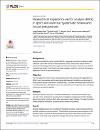| Abstract | Background Bioelectrical impedance vector analysis (BIVA) is a general concept that includes all methodologies used in the analysis of the bioelectrical vector, whereas the "classic" BIVA is a patented methodology included among these methods of analysis. Once this was clarified, the systematic review of the literature provides a deeper insight into the scope and range of application of BIVA in sport and exercise. Objective The main goal of this work was to systematically review the sources on the applications of BIVA in sport and exercise and to examine its usefulness and suitability as a technique for the evaluation of body composition, hydration status, and other physiological and clinical relevant characteristics, ultimately to trace future perspectives in this growing area, including a proposal for a research agenda. Methods Systematic literature searches in PubMed, SPORTDiscus and Scopus databases up to July, 2017 were conducted on any empirical investigations using phase-sensitive bioimpedance instruments to perform BIVA within exercise and sport contexts. The search included healthy sedentary individuals, physically active subjects and athletes. Result Nineteen eligible papers were included and classified as sixteen original articles and three scientific conference communications. Three studies analysed short-term variations in the hydration status evoked by exercise/training through whole-body measurements, eleven assessed whole-body body composition changes induced by long-term exercise, four compared athletic groups or populations using the whole-body assessment, and two analysed bioelectrical patterns of athletic injuries or muscle damage through localised bioimpedance measurements. Conclusions BIVA is a relatively new technique that has potential in sport and exercise, especially for the assessment of soft-tissue injury. On the other hand, the current tolerance ellipses of “classic” BIVA are not a valid method to identify dehydration in individual athletes and a new approach is needed. “Specific” BIVA, a method which proposes a correction of bioelectrical values for body geometry, emerges as the key to overcome “classic” BIVA limitations regarding the body composition assessment. Further research establishing standardised testing procedures and investigating the relationship between physiology and the bioelectrical signal in sport and exercise is needed. © 2018 Castizo-Olier et al. This is an open access article distributed under the terms of the Creative Commons Attribution License, which permits unrestricted use, distribution, and reproduction in any medium, provided the original author and source are credited. |


